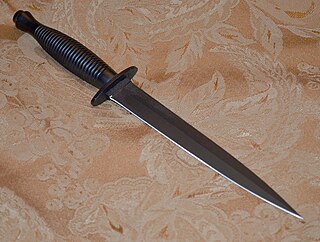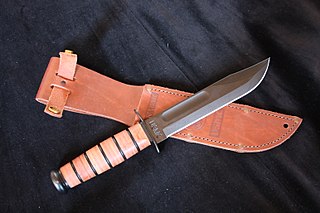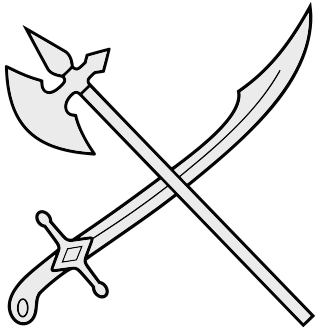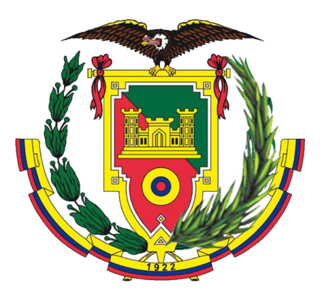
A dagger is a fighting knife with a very sharp point and usually two sharp edges, typically designed or capable of being used as a thrusting or stabbing weapon. Daggers have been used throughout human history for close combat confrontations, and many cultures have used adorned daggers in ritual and ceremonial contexts. The distinctive shape and historic usage of the dagger have made it iconic and symbolic. A dagger in the modern sense is a weapon designed for close-proximity combat or self-defense; due to its use in historic weapon assemblages, it has associations with assassination and murders. Double-edged knives, however, play different sorts of roles in different social contexts.

A knife is a tool or weapon with a cutting edge or blade, usually attached to a handle or hilt. One of the earliest tools used by humanity, knives appeared at least 2.5 million years ago, as evidenced by the Oldowan tools. Originally made of wood, bone, and stone, over the centuries, in step with improvements in both metallurgy and manufacturing, knife blades have been made from copper, bronze, iron, steel, ceramic, and titanium. Most modern knives have either fixed or folding blades; blade patterns and styles vary by maker and country of origin.

A machete is a broad blade used either as an agricultural implement similar to an axe, or in combat like a long-bladed knife. The blade is typically 30 to 45 centimetres long and usually under 3 millimetres thick. In the Spanish language, the word is possibly a diminutive form of the word macho, which was used to refer to sledgehammers. Alternatively, its origin may be machaera, the name given by the Greeks and Romans to the falcata. It is the origin of the English language equivalent term matchet, though this is less commonly used. In much of the English-speaking Caribbean, such as Jamaica, Barbados, Guyana, Grenada, and Trinidad and Tobago, the term cutlass is used for these agricultural tools.

A bayonet is a knife, dagger, sword, or spike-shaped weapon designed to fit on the end of the muzzle of a rifle, carbine, musket or similar firearm, allowing it to be used as a spear-like weapon. From the early 17th to the early 20th century, it was a melee weapon used by infantry for offensive and/or defensive tactics. Today, it is considered an ancillary weapon or weapon of last resort, although it is still used for ceremonial purposes.

Filipino martial arts (FMA) refer to ancient and newer modified fighting methods devised in the Philippines. It incorporates elements from both Western and Eastern Martial Arts, the most popular forms of which are known as Arnis, Eskrima, and Kali. The intrinsic need for self-preservation was the genesis of these systems. Throughout the ages, invaders and evolving local conflict imposed new dynamics for combat in the islands now making up the Philippines. The Filipino people developed battle skills as a direct result of an appreciation of their ever-changing circumstances. They learned often out of necessity how to prioritize, allocate and use common resources in combative situations. Filipinos have been heavily influenced by a phenomenon of cultural and linguistic mixture. Some of the specific mechanisms responsible for cultural and martial change extended from phenomena such as war, political and social systems, technology, trade and practicality.

A bolo is a general term for traditional pre-colonial small to medium-sized single-edged swords or large knives of the Philippines that function as both tools and weapons. They are characterized by a curved wide blade that narrows towards the hilt, with pointed or blunt tips. Bolos are a common tool in the Philippines and are often compared to the machete.
A stiletto is a specialized knife or dagger with a long slender blade and needle-like point, primarily intended as a thrusting and stabbing weapon.

A fascine is a rough bundle of brushwood or other material used for strengthening an earthen structure, or making a path across uneven or wet terrain. Typical uses are protecting the banks of streams from erosion, covering marshland, or providing ground improvement in a manner similar to that of modern geotextiles.

The aruval ,(Telugu:కొడవలి kodvali/ kodivelu) also known as koḍuvāḷ, is a type of billhook machete from southern India, particularly common in the Indian states of Andhra Pradesh, Tamil Nadu and Kerala. It is a type of long sickle with a knife-like scythe-handle, and is used both as a tool and a weapon. Tamils reserve the weapon as a symbol of karupannar. In popular culture, it is sometimes associated with gangsters especially in rayalseema region of Andhra Pradesh. In movies, it is used as a weapon of choice. In Kerala, its primary use is for agriculture, mainly in coconut cutting, clearing pathways, cutting wood and other uses.

The Structure of the Argentine Army follows below. As of 2020 the active force of the Argentine Army includes a total of eleven brigades:

A billhook or bill hook, also called a pruning knife or spar hook, is a versatile cutting tool used widely in agriculture and forestry for cutting woody material such as shrubs, small trees and branches. It is distinct from the sickle. It was commonly used in Europe with an important variety of traditional local patterns. Elsewhere, it was also developed locally such as in the Indian subcontinent, or introduced regionally as in the Americas, South Africa, and Oceania by European settlers.
A combat knife is a fighting knife designed for military use and primarily intended for hand-to-hand or close combat fighting.

Ka-Bar is the contemporary popular name for the combat knife first adopted by the United States Marine Corps in November 1942 as the 1219C2 combat knife, and subsequently adopted by the United States Navy as the U.S. Navy utility knife, Mark 2. Ka-Bar is the name of a related knife manufacturing company, Ka-Bar Knives., Inc., of Olean, New York, a subsidiary of the Cutco Corporation.

A fighting knife has a blade designed to most effectively inflict injury in close-quarters physical confrontations. The combat knife and the trench knife are examples of military fighting knives.

The National Armyof Uruguay is the land force branch of the Armed Forces of the Oriental Republic of Uruguay.

The Museum of the Army is a national museum located in Toledo, Spain, attached to the Ministry of Defence.

An edged weapon, or bladed weapon, is a melee weapon with a cutting edge. Bladed weapons include swords, daggers, knives, and bayonets. Edged weapons are used to cut, hack, or slash; some edged weapons may also permit thrusting and stabbing. Edged weapons contrast with blunt weapons such as maces, and with thrusting weapons such as spears.

The Armed Forces University – ESPE, which can also be translated as Polytechnical School of the Army, formerly called "Escuela Politécnica del Ejército" ESPE is a higher education university in Sangolquí, Pichincha Province, Ecuador. Established on June 16, 1922, it originated from the Escuela de Oficiales Ingenieros, created by the Ecuadorian President José Luis Tamayo.
The Sorocaban knife is a type of knife or short sword developed in Brazil, more precisely the state of São Paulo, around the turn of 18th to the 19th century. Its defining characteristics are the long and slender single-edged blade, the distinctive handle profile, tapering to a rounded pommel, and the enterçado construction technique, in which the blade is inserted into a slit opened in the ricasso and then fixed in place by three rivets.

The Commemorative Medal of the Fifth Centenary of the Proclamation of Saint Bárbara as Patron of the Artillery Weapon, commonly called the Medal of the V Centenary of Saint Barbara, is an official Spanish decoration created on December 4, 2021 to commemorate the five hundred years of patronage of Santa Barbara to the components of the Artillery Weapon of the Spanish Armed Forces. Created by the Military Archbishopric of Spain by virtue of the Agreements between the Spanish State and the Holy See of 1979, decreed by D. Carlos Jesús Montes Herreros, Military Ordinary of Spain, after the death of the Military Archbishop of Spain Juan del Río Martín in January of that same year, and the consecration of the newly appointed Military Archbishop-elect Juan Antonio Aznárez Cobo is still pending.


















